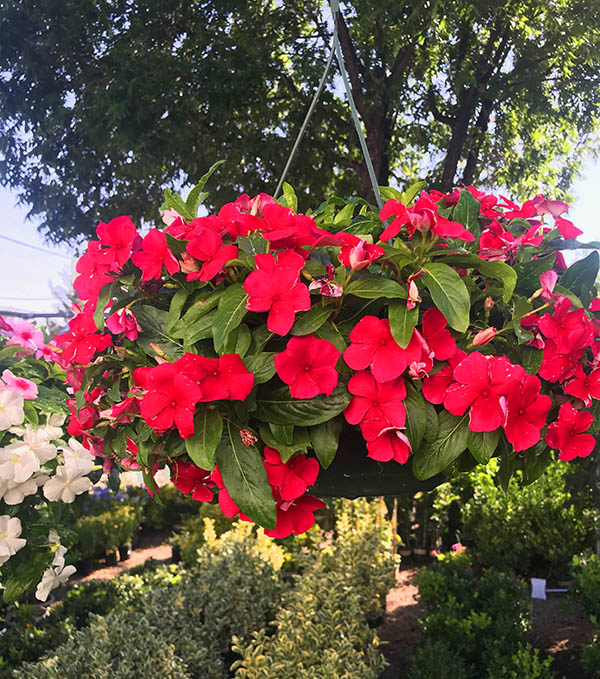Last updated on April 13th, 2024 at 08:04 am
Vinca Plant Care. Vinca Plants (Catharanthus roseus) Is a colorful plant that can tolerate heat. Commonly known as Madagascar periwinkle. They come in bright red, white, pink, and purple and they thrive in full sun providing you water them every other day or so. Thick glossy leaves that repel insects.
Do not get them confused with the trailing or vinca minor plants. AKA the periwinkle vine with a blue or violet flower. You can see it on this page Ground Cover Plants.
These plants will flower from mid-spring into mid-fall.
How to keep Vinca Flowering?
Fertilize them often about once every 2 weeks or so. A good all-purpose fertilizer with an analysis of 20-20-20 will work. It’s important that the soil drains well.
This will help with growth and blooms throughout the growing season. The growing season is from mid-spring till about mid-fall.

Vinca Plant Care
They will also do great in containers. You can also plant them in the ground but in and around the higher elevations of the Southwest US, it is considered an annual. They will grow up to 8″ in height and will spread about 2-4″ wide.
They are considered a nuisance plant in tropical areas but around the southwest, this will not become a problem.
Where to plant Annual Vinca?
Plant them in rock gardens, or pots in front of your home and they don’t mind the full sun, they will also do well in the morning sun and afternoon shade.

Vinca in Hanging Baskets
All plants in hanging baskets need a little more attention as opposed to planting them in the ground. Vinca plants in hanging baskets need to be watered every other day during mid-spring and mid-fall. During the hot summertime, they need water every day. Yes, every day and mornings are more beneficial than afternoon watering.
Constant watering will leech out the nutrients in a hanging basket. It is best to fertilize at least once per month during the growing seasons. This is typically spring, summer, and early fall.

Purple Vinca for the Garden
Fertilizing Madagascar Periwinkle
As for fertilizer, Madagascar periwinkles are not heavy feeders. A light application of a balanced fertilizer in the spring should be sufficient to keep them healthy and blooming. Be sure to follow the instructions on the fertilizer package to avoid overfeeding.
Lastly, keep an eye out for any pests or diseases that may affect your Madagascar periwinkle. While they are generally resistant to most common pests and diseases, it’s always a good idea to inspect your plants regularly and take action if necessary. Removing any diseased or damaged leaves will help prevent the spread of any potential issues.
Problems with Vinca?
The Vinca plant is a very hardy easy-to-grow plant, but it is susceptible to root rot so be extra sure your containers or soil drains well. Water in the morning to help with fungus problems. The thick leaves will help keep insects away, but aphids and mites will attack this plant. Spray with an insecticide spray at the first sign of these pests. More information here on how to get rid of these insects. It is important to note that Vinca Madagascar periwinkle is deer and rabbit-resistant.
In conclusion, caring for Madagascar periwinkles is relatively easy and rewarding. With the right location, well-drained soil, proper watering, and occasional fertilizing, you’ll be able to enjoy the vibrant blooms of this beautiful plant throughout the growing season. So go ahead and add some Madagascar periwinkles to your garden – they’re sure to bring a pop of color and joy!
Learn more about this plant over at Wikipedia.







Paul, a question and a comment. Q – last year I had a problem with my tomatoes have the ends brown and ‘slimy’. Not good. What can I do to prevent? I bought Early Girl and Sweet 100 from Color Your World. Plants doing great, but want good tomatoes. Comment, we plant Vincas because durable and attractive, and the rabbits and deer do not eat them (we live at Elephant Butte).
Hello, John. What you have is called “blossom end rot” on your tomatoes and is caused by not having enough calcium in your soil.
There are all kinds of ways to help with this problem online. From powdered milk to eggshells. But the easiest solution is to purchase calcium nitrate. and work it into your soil. It’s important to note that tomatoes that have this will not regain their skin or look even after applying calcium nitrate or any other calcium, however, the tomato plant should recover and produce good tomatoes.
So when is the right time to apply calcium nitrate to the sil for tomatoe blossom end rot? Before blossoms/fruits start to develop? Or after blossoms or fruit starts to develop?
You can apply calcium nitrate right now. There is still Time…if you wait until mid-summer it is too late.
Thanks, hope that you have in stock.